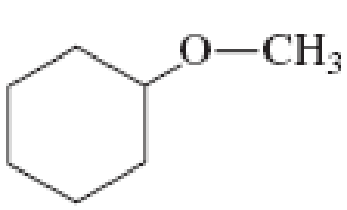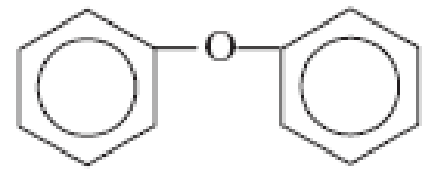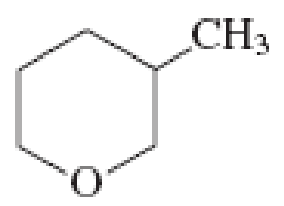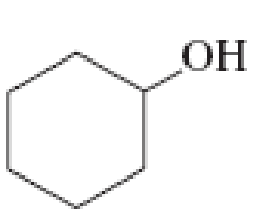
Organic And Biological Chemistry
7th Edition
ISBN: 9781305638686
Author: H. Stephen Stoker
Publisher: Brooks Cole
expand_more
expand_more
format_list_bulleted
Textbook Question
Chapter 3, Problem 3.127EP
Classify each of the following molecular structures as that of a cyclic ether, a noncyclic ether, or a nonether.




Expert Solution & Answer
Trending nowThis is a popular solution!

Students have asked these similar questions
In a photochemical reaction, how is the rate of the process related to its quantum yield?
Primary and global quantum yields in photochemistry. Define them and give their formulas. Differentiate between them.
Help me solve my HW
Chapter 3 Solutions
Organic And Biological Chemistry
Ch. 3.1 - Prob. 1QQCh. 3.1 - Prob. 2QQCh. 3.2 - Prob. 1QQCh. 3.2 - Prob. 2QQCh. 3.2 - Prob. 3QQCh. 3.3 - Prob. 1QQCh. 3.3 - Prob. 2QQCh. 3.3 - Prob. 3QQCh. 3.3 - Prob. 4QQCh. 3.4 - Prob. 1QQ
Ch. 3.4 - Prob. 2QQCh. 3.4 - Prob. 3QQCh. 3.5 - Prob. 1QQCh. 3.5 - Prob. 2QQCh. 3.5 - Prob. 3QQCh. 3.5 - Prob. 4QQCh. 3.6 - Prob. 1QQCh. 3.6 - Prob. 2QQCh. 3.6 - Prob. 3QQCh. 3.7 - Prob. 1QQCh. 3.7 - Prob. 2QQCh. 3.8 - Prob. 1QQCh. 3.8 - Prob. 2QQCh. 3.9 - Prob. 1QQCh. 3.9 - Prob. 2QQCh. 3.9 - Prob. 3QQCh. 3.9 - Prob. 4QQCh. 3.9 - Prob. 5QQCh. 3.9 - Prob. 6QQCh. 3.10 - Prob. 1QQCh. 3.10 - Prob. 2QQCh. 3.11 - Prob. 1QQCh. 3.11 - Prob. 2QQCh. 3.11 - Prob. 3QQCh. 3.12 - Prob. 1QQCh. 3.12 - Prob. 2QQCh. 3.13 - Prob. 1QQCh. 3.13 - Prob. 2QQCh. 3.13 - Prob. 3QQCh. 3.14 - Prob. 1QQCh. 3.14 - Prob. 2QQCh. 3.14 - Prob. 3QQCh. 3.15 - Prob. 1QQCh. 3.15 - Prob. 2QQCh. 3.15 - Prob. 3QQCh. 3.15 - Prob. 4QQCh. 3.16 - Prob. 1QQCh. 3.16 - Prob. 2QQCh. 3.17 - Prob. 1QQCh. 3.17 - Prob. 2QQCh. 3.17 - Prob. 3QQCh. 3.18 - Prob. 1QQCh. 3.18 - Prob. 2QQCh. 3.18 - Prob. 3QQCh. 3.19 - Prob. 1QQCh. 3.19 - Prob. 2QQCh. 3.20 - Prob. 1QQCh. 3.20 - Prob. 2QQCh. 3.20 - Prob. 3QQCh. 3.20 - Prob. 4QQCh. 3.20 - Prob. 5QQCh. 3.21 - Prob. 1QQCh. 3.21 - Prob. 2QQCh. 3.21 - Prob. 3QQCh. 3.21 - Prob. 4QQCh. 3.21 - Prob. 5QQCh. 3 - Prob. 3.1EPCh. 3 - Indicate whether or not each of the following...Ch. 3 - Prob. 3.3EPCh. 3 - Prob. 3.4EPCh. 3 - Prob. 3.5EPCh. 3 - Prob. 3.6EPCh. 3 - Prob. 3.7EPCh. 3 - Prob. 3.8EPCh. 3 - Prob. 3.9EPCh. 3 - Prob. 3.10EPCh. 3 - Write a condensed structural formula for each of...Ch. 3 - Write a condensed structural formula for each of...Ch. 3 - Prob. 3.13EPCh. 3 - Prob. 3.14EPCh. 3 - Prob. 3.15EPCh. 3 - Prob. 3.16EPCh. 3 - Prob. 3.17EPCh. 3 - Prob. 3.18EPCh. 3 - Prob. 3.19EPCh. 3 - Prob. 3.20EPCh. 3 - Prob. 3.21EPCh. 3 - Prob. 3.22EPCh. 3 - Prob. 3.23EPCh. 3 - Prob. 3.24EPCh. 3 - Prob. 3.25EPCh. 3 - Prob. 3.26EPCh. 3 - Prob. 3.27EPCh. 3 - Prob. 3.28EPCh. 3 - Prob. 3.29EPCh. 3 - Prob. 3.30EPCh. 3 - Give the IUPAC name of the alcohol that fits each...Ch. 3 - Prob. 3.32EPCh. 3 - Prob. 3.33EPCh. 3 - Prob. 3.34EPCh. 3 - Prob. 3.35EPCh. 3 - Prob. 3.36EPCh. 3 - Prob. 3.37EPCh. 3 - Which member of each of the following pairs of...Ch. 3 - Prob. 3.39EPCh. 3 - Which member of each of the following pairs of...Ch. 3 - Determine the maximum number of hydrogen bonds...Ch. 3 - Prob. 3.42EPCh. 3 - Prob. 3.43EPCh. 3 - Prob. 3.44EPCh. 3 - Prob. 3.45EPCh. 3 - Prob. 3.46EPCh. 3 - Classify each of the following alcohols as a...Ch. 3 - Classify each of the following alcohols as a...Ch. 3 - Classify each of the following alcohols as a...Ch. 3 - Classify each of the following alcohols as a...Ch. 3 - Prob. 3.51EPCh. 3 - Prob. 3.52EPCh. 3 - Prob. 3.53EPCh. 3 - Prob. 3.54EPCh. 3 - Prob. 3.55EPCh. 3 - Prob. 3.56EPCh. 3 - Prob. 3.57EPCh. 3 - Prob. 3.58EPCh. 3 - Prob. 3.59EPCh. 3 - Prob. 3.60EPCh. 3 - The alcohol 2,2-dimethyl-1-butanol cannot be...Ch. 3 - Prob. 3.62EPCh. 3 - Prob. 3.63EPCh. 3 - Prob. 3.64EPCh. 3 - Prob. 3.65EPCh. 3 - Prob. 3.66EPCh. 3 - Prob. 3.67EPCh. 3 - Prob. 3.68EPCh. 3 - Prob. 3.69EPCh. 3 - Prob. 3.70EPCh. 3 - Prob. 3.71EPCh. 3 - Prob. 3.72EPCh. 3 - Prob. 3.73EPCh. 3 - Prob. 3.74EPCh. 3 - Prob. 3.75EPCh. 3 - Prob. 3.76EPCh. 3 - Prob. 3.77EPCh. 3 - Prob. 3.78EPCh. 3 - Prob. 3.79EPCh. 3 - Prob. 3.80EPCh. 3 - Prob. 3.81EPCh. 3 - Prob. 3.82EPCh. 3 - Prob. 3.83EPCh. 3 - Prob. 3.84EPCh. 3 - Prob. 3.85EPCh. 3 - Prob. 3.86EPCh. 3 - Prob. 3.87EPCh. 3 - Prob. 3.88EPCh. 3 - Prob. 3.89EPCh. 3 - Prob. 3.90EPCh. 3 - Classify each of the following compounds as an...Ch. 3 - Prob. 3.92EPCh. 3 - Draw or write the following for the simplest ether...Ch. 3 - Draw or write the following for the simplest ether...Ch. 3 - Prob. 3.95EPCh. 3 - Prob. 3.96EPCh. 3 - Assign a common name to each of the ethers in...Ch. 3 - Prob. 3.98EPCh. 3 - Prob. 3.99EPCh. 3 - Prob. 3.100EPCh. 3 - Prob. 3.101EPCh. 3 - Prob. 3.102EPCh. 3 - Prob. 3.103EPCh. 3 - Prob. 3.104EPCh. 3 - Prob. 3.105EPCh. 3 - Prob. 3.106EPCh. 3 - Prob. 3.107EPCh. 3 - Prob. 3.108EPCh. 3 - Prob. 3.109EPCh. 3 - Prob. 3.110EPCh. 3 - Prob. 3.111EPCh. 3 - Prob. 3.112EPCh. 3 - Prob. 3.113EPCh. 3 - Prob. 3.114EPCh. 3 - How many isomeric ethers exist when the R groups...Ch. 3 - Prob. 3.116EPCh. 3 - Prob. 3.117EPCh. 3 - Prob. 3.118EPCh. 3 - Prob. 3.119EPCh. 3 - Prob. 3.120EPCh. 3 - Dimethyl ether and ethanol have the same molecular...Ch. 3 - Prob. 3.122EPCh. 3 - Prob. 3.123EPCh. 3 - Prob. 3.124EPCh. 3 - Prob. 3.125EPCh. 3 - Prob. 3.126EPCh. 3 - Classify each of the following molecular...Ch. 3 - Classify each of the following molecular...Ch. 3 - Prob. 3.129EPCh. 3 - Prob. 3.130EPCh. 3 - Prob. 3.131EPCh. 3 - Draw a condensed structural formula for each of...Ch. 3 - Prob. 3.133EPCh. 3 - Prob. 3.134EPCh. 3 - Prob. 3.135EPCh. 3 - Write the formulas for the sulfur-containing...Ch. 3 - Prob. 3.137EPCh. 3 - For each of the following pairs of compounds,...Ch. 3 - Prob. 3.139EPCh. 3 - Prob. 3.140EPCh. 3 - Prob. 3.141EPCh. 3 - Prob. 3.142EPCh. 3 - Prob. 3.143EPCh. 3 - Prob. 3.144EPCh. 3 - Prob. 3.145EPCh. 3 - Prob. 3.146EP
Knowledge Booster
Learn more about
Need a deep-dive on the concept behind this application? Look no further. Learn more about this topic, chemistry and related others by exploring similar questions and additional content below.Similar questions
arrow_back_ios
SEE MORE QUESTIONS
arrow_forward_ios
Recommended textbooks for you
 Organic And Biological ChemistryChemistryISBN:9781305081079Author:STOKER, H. Stephen (howard Stephen)Publisher:Cengage Learning,
Organic And Biological ChemistryChemistryISBN:9781305081079Author:STOKER, H. Stephen (howard Stephen)Publisher:Cengage Learning, General, Organic, and Biological ChemistryChemistryISBN:9781285853918Author:H. Stephen StokerPublisher:Cengage Learning
General, Organic, and Biological ChemistryChemistryISBN:9781285853918Author:H. Stephen StokerPublisher:Cengage Learning Chemistry: Principles and PracticeChemistryISBN:9780534420123Author:Daniel L. Reger, Scott R. Goode, David W. Ball, Edward MercerPublisher:Cengage Learning
Chemistry: Principles and PracticeChemistryISBN:9780534420123Author:Daniel L. Reger, Scott R. Goode, David W. Ball, Edward MercerPublisher:Cengage Learning Introductory Chemistry: An Active Learning Approa...ChemistryISBN:9781305079250Author:Mark S. Cracolice, Ed PetersPublisher:Cengage Learning
Introductory Chemistry: An Active Learning Approa...ChemistryISBN:9781305079250Author:Mark S. Cracolice, Ed PetersPublisher:Cengage Learning Chemistry for Today: General, Organic, and Bioche...ChemistryISBN:9781305960060Author:Spencer L. Seager, Michael R. Slabaugh, Maren S. HansenPublisher:Cengage Learning
Chemistry for Today: General, Organic, and Bioche...ChemistryISBN:9781305960060Author:Spencer L. Seager, Michael R. Slabaugh, Maren S. HansenPublisher:Cengage Learning

Organic And Biological Chemistry
Chemistry
ISBN:9781305081079
Author:STOKER, H. Stephen (howard Stephen)
Publisher:Cengage Learning,

General, Organic, and Biological Chemistry
Chemistry
ISBN:9781285853918
Author:H. Stephen Stoker
Publisher:Cengage Learning

Chemistry: Principles and Practice
Chemistry
ISBN:9780534420123
Author:Daniel L. Reger, Scott R. Goode, David W. Ball, Edward Mercer
Publisher:Cengage Learning

Introductory Chemistry: An Active Learning Approa...
Chemistry
ISBN:9781305079250
Author:Mark S. Cracolice, Ed Peters
Publisher:Cengage Learning

Chemistry for Today: General, Organic, and Bioche...
Chemistry
ISBN:9781305960060
Author:Spencer L. Seager, Michael R. Slabaugh, Maren S. Hansen
Publisher:Cengage Learning

07 Physical Properties of Organic Compounds; Author: Mindset;https://www.youtube.com/watch?v=UjlSgwq4w6U;License: Standard YouTube License, CC-BY